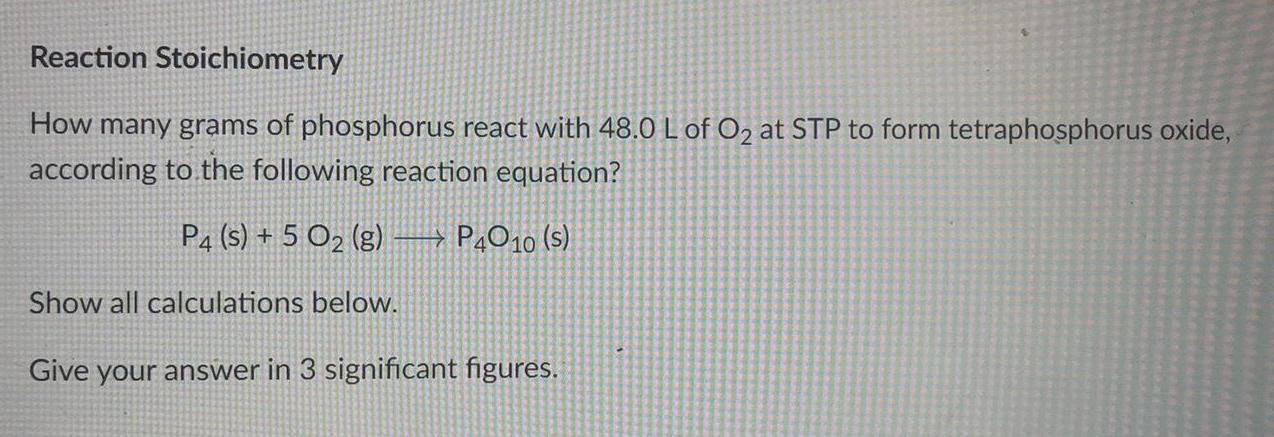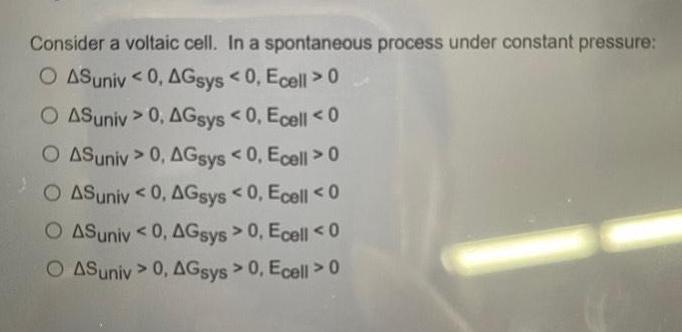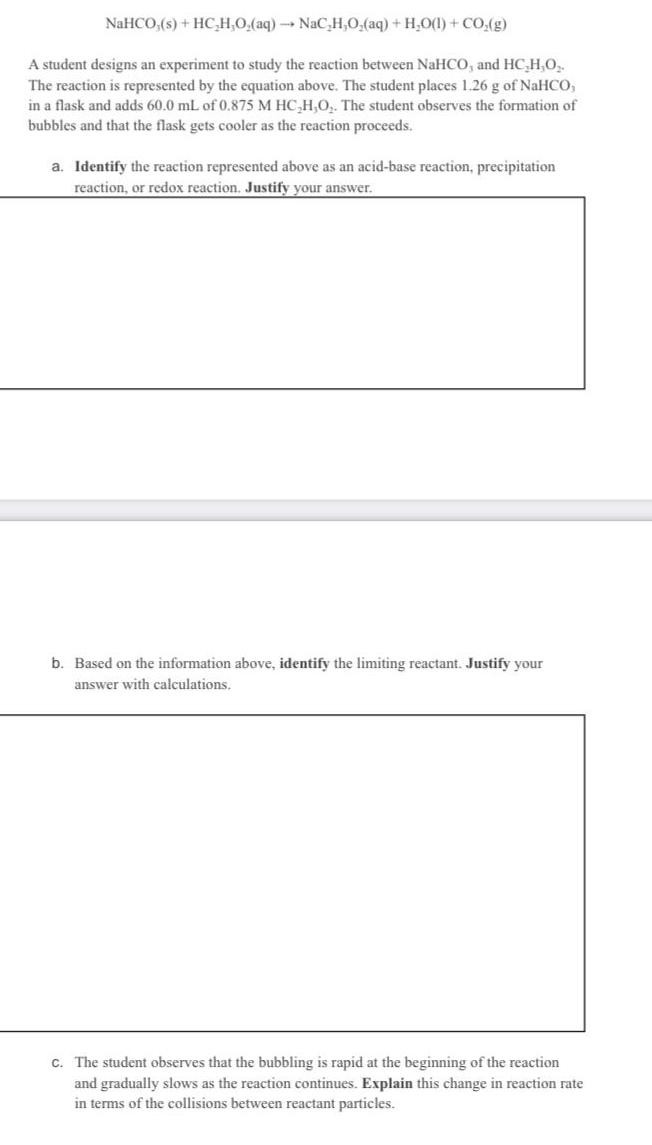General Questions and Answers

Physical Chemistry
GeneralType in the name of (NH4)3ASO4 Read this:
Use your periodic table and the polyatomic ion chart to ensure correct spelling.
Type in all lowercase letters.
Place Roman Numerals in parentheses as needed.
Put one space in between each word
Example: iron (II) phosphate

Physical Chemistry
GeneralIn which example is the entropy of the initial state greater than the entropy of the final
state?
1. Liquid water evaporates.
2. A building collapses during an earth-quake.
3. A lump of sugar dissolves in a cup of warm water.
4. Liquid water freezes into ice.

Physical Chemistry
GeneralReaction Stoichiometry
How many grams of phosphorus react with 48.0 L of O₂ at STP to form tetraphosphorus oxide,
according to the following reaction equation?
P4 (s) + 5 O2 (g) ->P4010 (s)
Show all calculations below. Give your answer in 3 significant figures.

Physical Chemistry
GeneralConsider a voltaic cell. In a spontaneous process under constant pressure:
O AS univ <0, AGsys < 0, Ecell > 0
O ASuniv> 0, AGsys < 0, Ecell <0
O AS univ> 0, AGsys < 0, Ecell > 0
O ASuniv <0, AGsys < 0, Ecell < 0
O AS univ <0, AGsys > 0, Ecell <0
O AS univ> 0, AGsys > 0, Ecell > 0

Physical Chemistry
GeneralIn a chemical reaction, the reactants combine to form the final product. Before making the final product, they form an intermediate complex:
C + D → CD → E
The reactants C and D form intermediate molecule CD and then molecule E. The
enthalpy change of reaction does not depend on the
Nature of reactants and products
State of reactants and products
Nature of the intermediate molecule
Nature of C, D, and E
Initial and final enthalpies of the reaction

Physical Chemistry
GeneralGive the chemical formula for lead (IV) carbonate. Read this:
When typing in your answer:
use capital and lowercase letters appropriately.
do not put spaces in between letters or numbers (or anything!) in the compound
use parentheses only when necessary
do not include subscripts of 1
use a regular sized numbers for subscripts
For example: Pb3N4 would be entered as Pb3N4
(NH4)2SO4 would be entered as (NH4)2SO4

Physical Chemistry
GeneralType in the name of Sn(CrO4)2 Read this:
Use your periodic table and the polyatomic ion chart to ensure correct spelling.
Type in all lowercase letters.
Place Roman Numerals in parentheses as needed.
Put one space in between each word
Example: iron (II) phosphate

Physical Chemistry
GeneralWhich products are formed when an acid reacts with a base?
an ester and water
water and carbon dioxide
Salt and water
a soap and glycerine

Physical Chemistry
GeneralConsider the exothermic reaction: x2 + y2 → 2 xy Information obtained from the potential energy diagram is:
Ea(fwd) = 143 kJ and Ea(rev) = 175 kJ. AH for the reaction will be
318 kJ
32 kJ
-318 J
-32 kJ
143 kJ

Physical Chemistry
GeneralWhich of the following would occur if solid NH4Cl was added to an aqueous solution of NH3?
The pH decreases.
The equilibrium constant changes.
NH3 will ionize to a greater extent.
The pH increases.

Physical Chemistry
GeneralThe combustion of titanium with oxygen produces titanium dioxide:
Ti (s) + O2(g) →→ TiO2 (s)
When 0.610 g of titanium is combusted in a bomb calorimeter, the temperature of the calorimeter increases from 25.00 °C to 50.50 °C. In a separate experiment, the heat capacity of the calorimeter is measured to be 9.84 kJ/K. The heat of reaction for thecombustion of a mole of Ti in this calorimeter is _____
kJ/mol.

Physical Chemistry
Generala) What volume of a solution of 0.2809 M sodium iodide is required to react with exactly 43.88 mL of 0.3248 M copper(II) nitrate according to the reaction
2Cu(NO3)2(aq) + 4KI(aq) → 2Cul(s) + I2(aq) + 4NaNO3(aq)
b) Which element gets oxidized and which element gets reduced? Give oxidation numbers
for each.

Physical Chemistry
GeneralHow does the enthalpy of the reaction depend on the number of steps in the reaction mechanism?
The value of the AH is unrelated to the number of steps in the mechanism
A multi-step reaction always has positive ΔH when compared to a single-step reaction
Each additional step in a reaction increases the ΔH
A multi-step reaction always has negative ΔH when compared to a single-step reaction

Physical Chemistry
GeneralWhat is the name of the salt produced from the reaction of calcium hydroxide and sulfuric acid?
calcium sulfite
calcium sulfate
calcium thiosulfate
calcium sulfide

Physical Chemistry
GeneralPractice problem 1: A student used 0.1153 g of ascorbic
acid to prepare 50 mL of AA solution. A titration of 2.50
mL of the solution required 26.50 mL of DCP solution.
What is the molarity of the DCP solution?

Physical Chemistry
GeneralN₂O3(g) + 6H2(g) → 2 NH3(g) + 3 H₂O(g)
0.22 mol of N2O3(g) react with 0.87 mol of H₂(g) According
to the equation above, how many moles of NH3(g) will
form?
a.0.29 mol
b.44 mol
c.73 mol
d. 1.1 mol

Physical Chemistry
GeneralWhat is the hydroxide ion concentration for a solution with pH of 4?
1x 10-10 M
1x 10-4 M
1x 10-14 M
1x 107 M

Physical Chemistry
GeneralA 10.1 g sample of NaOH is dissolved in 250.0 g of water in a coffee-cup calorimeter.
The temperature increases from 23.0 °C to ____________ °C. Specific heat of liquid water is 4.18 J/g-K and AH for the dissolution of sodium hydroxide in water is 44.4 kJ/mol.
35.2
24.0
33.7
33.3
40.2

Physical Chemistry
GeneralUse your own words and captured images
from the simulation to show you can
measure:
a. Wavelength of longest wave possible
answer here
b. Wavelength of shortest wave
possible answer here
c. Height of tallest wave possible
answer here

Physical Chemistry
GeneralWhich equation shows the total molecular reaction between potassium carbonate and phosphoric acid?
CO3(aq) + 3 H+(aq) → 3 CO₂(g) + 3 H₂O(/)
3 K2CO3(aq) + 2H3PO4(aq) → 2 K3PO4(aq) + 3 H₂CO3(aq)
3 K+(aq) + PO4³-(aq) → 2 K3PO3(aq)
3 K₂CO3(aq) + 2 H3PO4(aq) → 2 K3PO3(aq) + 3 CO₂(g) + 3 H₂O(L)

Physical Chemistry
GeneralIdentify whether each of the following solutions is acidic, basic, or neutral.
Drag the appropriate items to their respective bins.
shampoo, pH 5.5 rain, pH 5.8 bath soap, pH 8.92 soda, pH 3.61 maple syrup, pH 5.5 honey, pH 3.6

Physical Chemistry
GeneralWhen 25.0 g of CH, COOH is combusted in a sealed calorimeter, it releases enough energy to heat 5.30 L of water from 17.7 °C to 29.3 °C.
a) Use this information to calculate the molar enthalpy of combustion for CH3COOH
b) Determine the final temperature if 750 mL of 27.3 °C water is heated by combusting 3.9 grams of CH3COOH
a) AcombH°
in kJ/mol
Tj
in °C

Physical Chemistry
GeneralWhat type(s) of intermolecular forces are expected between CH3CONHCH₂CH3 molecules?
Indicate with a Y (yes) or an N (no) which apply.
dipole forces
induced dipole (London dispersion) forces
hydrogen bonding

Physical Chemistry
GeneralDraw the Lewis structures and assign formal charges for the cyanate ion and the fulminate ion. (C is the central atom in OCN and N is the central atom in CNO.) Include all resonance structures for each ion, and assign non-zero formal charges next to each atom.

Physical Chemistry
GeneralBacteria produce methane gas in sewage-treatment plants. This gas is often captured or burned. If a bacterial culture produces 60.0 mL of methane gas at 700.0 mmHg, at what pressure would the bacteria be able to produce 55.0 mL of gas? What law did you use to solve?

Physical Chemistry
GeneralA sample of xenon gas at a pressure of 0.623 atm and a temperature of 23.3°C, occupies a volume of 10.1 L. If the gas is compressed at constant temperature to a volume of 5.69 L, the pressure of the gas sample will be atm.

Physical Chemistry
GeneralWhich of the following steps can be used to identify a single replacement reaction?
Check whether the products are salt and water.
Check whether the reactants are an acid and a base.
Check if the ions of two compounds exchange places.
Check if one element replaces another element in a compound.

Physical Chemistry
GeneralEnter your answer in the provided box.
A 2.76-L container of vinegar contains 3.2% (w/v) of acetic acid (C₂H4O2, molar mass 60.05 g/mol) in water.
a. How many grams of acetic acid are present in the container?
____g
b. How many moles of acetic acid are present in the container?
____mol
c. Convert the weight/volume percent concentration to molarity.
____M

Physical Chemistry
GeneralA chemist dissolves 609. mg of pure sodium hydroxide in enough water to make up 90. mL of solution. Calculate the pH of the solution. (The temperature of the solution is 25 °C.)

Physical Chemistry
GeneralYana uses 16.4 liters of helium to blow
up a balloon for a party. If the room is
at STP, how many moles of helium did
she use?

Physical Chemistry
GeneralS + 6 HNO3 --> H₂SO4 + 6 NO2 + 2 H₂O
In the above equation how many moles of water can be made when 132.1 grams of HNO3 are consumed?
Round your answer to the nearest tenth. If you answer is a whole number like 4, report the answer as 4.0
Use the following molar masses. If you do not use these masses, the computer will mark your answer incorrect.:
Element Molar Mass
Hydrogen 1
Nitrogen 14
Sulfur 32
Oxygen 16

Physical Chemistry
GeneralA chemistry student weighs out 0.315 g of ascorbic acid (H₂C6H6O6), a diprotic acid, into a 250. mL volumetric flask and dilutes to the mark with distilled water. He plans to titrate the acid with 0.0600 M NaOH solution.
Calculate the volume of NaOH solution the student will need to add to reach the final equivalence point. Round your answer to 3 significant digits.

Physical Chemistry
General12. Several grams of sodium chloride are stirred into a glass of water and are no longer visible to the eye. Which of the following statements is FALSE?
a The sodium chloride solid has dissociated into its component ions.
b. An aqueous solution has been prepared.
c.No precipitate has formed.
d. Sodium chloride is insoluble in water.
e. All of the statements are true.
containing

Physical Chemistry
GeneralIn a mixture of 1.90 mol of gas, 0.85 mol are nitrogen (N₂) molecules. What is the mole fraction of N₂ in this mixture?
• Report your answer using two significant figures.

Physical Chemistry
GeneralNaHCO3(s)+HC2H3O2(aq)->NaC2H3O2(aq)+H2O(l)+CO2(g)
A student designs an experiment to study the reaction between NaHCO, and HC3H3O2.
The reaction is represented by the equation above. The student places 1.26 g of NaHCO, in a flask and adds 60.0 mL of 0.875 M HC,H,O,. The student observes the formation of bubbles and that the flask gets cooler as the reaction proceeds.
a. Identify the reaction represented above as an acid-base reaction, precipitation reaction, or redox reaction. Justify your answer.
b. Based on the information above, identify the limiting reactant. Justify your answer with calculations.
c. The student observes that the bubbling is rapid at the beginning of the reaction and gradually slows as the reaction continues. Explain this change in reaction rate in terms of the collisions between reactant particles.

Physical Chemistry
GeneralThe three most popular types of observation tools - anecdotal records, running records, and checklist - require training before a child care provider can use them to document children's behavior.
True
False

Physical Chemistry
GeneralNaHCO3(s)+HC2H3O2(aq) — NaC2H3O2(aq) +H2O(l) +CO2(g)
A student designs an experiment to study the reaction between NaHCO3, and HC₂H3O₂.
The reaction is represented by the equation above. The student places 1.26 g of NaHCO3 in a flask and adds 60.0 mL of 0.875 M HC₂H₂O₂. The student observes the formation of bubbles and that the flask gets cooler as the reaction proceeds.
a. Identify the reaction represented above as an acid-base reaction, precipitation reaction, or redox reaction. Justify your answer.

Physical Chemistry
GeneralA Rolaids tablet contains calcium carbonate to neutralize stomach acid. If titrating a Rolaids tablet requires 26.70 mL of 0.505 M hydrochloric acid, how many milligrams of
calcium carbonate are in the tablet?
CaCO3(s) + 2 HCl(aq) → CaCl₂ (aq) + H₂O(l) + CO2(g)

Physical Chemistry
GeneralA nitric acid solution is standardized using 0.500 g of sodium carbonate, Na2CO3. Find the molarity of the nitric acid if 38.50 mL are required to reach a permanent endpoint.
2 HNO3(aq) + Na₂CO3 (s) → 2 NaNO3(aq) + H₂O(l) + CO2(g)

Physical Chemistry
GeneralA team of scientists found a wooly mammoth under the ice in Siberia and decided to use C-14 dating to determine how long ago it lived. The initial activity of C-14 is 17.5 disintegrations/min/g of carbon. Currently, the decay rate is 2.68 disintegrations/min/g of carbon. The 1/2 life of C-14 is 5730 years. How long ago did the mammoth live?
yrs

Physical Chemistry
GeneralConcentrated aqueous perchloric acid is 70.5 wt% HCIO and has a concentration of 11.7 M.
Calculate the volume of concentrated perchloric acid that should be diluted to 1.40 L to form a 2.30 M HCIO4 solution.
volume: mL
Determine the density of 70.5 wt% HClO4.
density: g/mL

Physical Chemistry
GeneralAn EpiPen Jr., used to treat anaphalactic allergic reactions, contains 0.15 mg of epinephrine. The concentration of epinephrine in each syringe is 0.50 mg/mL. What is the volume, in milliliters (mL), of solution in each syringe?

Physical Chemistry
GeneralCalculate the force of gravity on the 1.5-kg mass if it were 1.3x10 m above Earth's surface (that is, if it were three Earth radii from Earth's center).

Physical Chemistry
GeneralIngredients that are less likely to cause allergies are referred to as:
a) Hyperallergenic
b) Hypoallergenic
c) Noncomedogenic
d) Comedogenic

Physical Chemistry
GeneralA 0.955-g sample of an unknown metal, with a charge of 2+, reacts with acid to liberate 380. mL of hydrogen gas when collected over water at 20.0 °C and 720. mmHg total pressure. What is the equivalent mass of the metal? What is the identity of the metal? (VP of water at 20°C = 17.5 mmHg)

Physical Chemistry
General(Mixing hot and cold water) 5 kg of water at 20°C is poured into a
bucket that contains 1 kg of water at 80°C. Find the equilibrium
temperature (neglect the influence of the bucket). Write your
answer in tenths. Only the numerical value will be graded.

Physical Chemistry
GeneralIn lab, you observed and classified multiple reactions. You mix a clear blue solution and a clear
yellow solution and observe the results to determine if a chemical reaction took place. Which of
the following is NOT an indication that a chemical reaction took place?
O The resulting mixture became neutral (underwent a pH change).
O An orange precipitate was formed.
O The resulting solution violently bubbled.
O The resulting solution appeared clear green.
O The resulting solution dropped in temperature.

Physical Chemistry
GeneralWhat volume in milliliters of CO gas would be produced by the complete reaction of
2.40 g of C solid at STP according to the following reaction? Remember 1 mol
of an ideal gas has a volume of 22.4 L at STP.
C(s) + H₂O(g) → CO(g) + H:(g)

Physical Chemistry
GeneralYou need to dilute a solution of 5.78 M sulfuric acid. You need the dilute solution to be 0.44 M
and only need 183. mL of it. How many mL of the concentrated solution are needed?
mL

Physical Chemistry
GeneralA gas stored in a container at 22.7°C has a pressure of 235 kPa is placed next to the fireplace. The temperature increased to 70.4. What is the pressure of the gas inside
the container?
(Answer in integer)